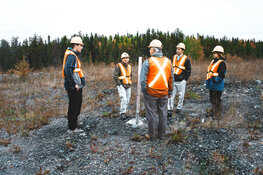Could another bubble burst like the "Dotcom Bubble," which helped usher in a decade-long gold bull market with extraordinary gains, be on its way?
Hussman Investment Trust President John Hussman, who predicted the Dotcom Bubble break and the market downturn in 2008, is warning that another fallout is coming soon.
"We estimate that current market conditions now 'cluster' among the worst 0.1% instances in history — more similar to major market peaks and dissimilar to major market lows than 99.9% of all post-war periods," Business Insider quoted Hussman as saying in a recent note.
Hussman said other such instances, including the Dotcom Bubble, are usually followed by an "abrupt" drop in the stock market.
For the savvy gold investor, that may be a big opportunity — like the big growth gold saw in the 2000s after the Dotcom Bubble burst.
"The Fed started to cut the federal funds rate in the response, gold started its impressive rally," according to GoldPriceForecast.com. "Many people did not want to invest in the stock market anymore, and they switched into the housing market (developing another speculative mania) and into . . . the precious metals market. The low-interest rates, weak greenback, and unsound U.S. fiscal policy made gold shine."
A team of J.P. Morgan analysts led by Khuram Chaudhry noted, "Rising concentration in the U.S. stock market has become an important risk that investors should be aware of in 2024."
On his website, Addicted to Profits, David Skarica also saw similarities with earlier gold markets and predicted the metal will rise in value "sometime this year."
Chaudhry and his team said there are differences between the Dotcom Bubble era and now, but the two are "more similar than one might initially expect."
"When viewed in a historical context, parallels to the 'Dotcom Bubble' era are often dismissed due to the 'irrational exuberance' that characterized this period. In this note, we demonstrate that there are a plethora of similarities between these two periods," said the note, reported on by MarketWatch.
And when it happens, investors should be ready, noted wealth advisor Ross Goldstein, who wrote that gold breaking records is a "rare and remarkable occurrence, given its historical long-term stability over thousands of years. The last time such groundbreaking price movements occurred was in the 1970s and the 2000s . . . The second gold bull market from 2000 to 2011 (after the Dotcom Bubble) exhibited almost an 8X rise."
According to Katusa Research, heightened uncertainty and decreased appetite for risk could send investors to gold. Also, a hard landing for the economy would justify more Fed rate cuts, "fanning the flames for higher gold prices."
"You need to be prepared," the site said. "If a roaring bull market sends the gold price above (US)$2,200 for any period of time, look out."
From Tulips to Blue Chips
According to Investopedia, an asset bubble happens "when the price of a financial asset or commodity rises to levels that are well above either historical norms, the asset's intrinsic value, or both."
Global analyst Adrian Day, writing for Streetwise Reports last month, said gold's "time has come."
Such bubbles are not new. One of the earliest recorded happened in Holland during the 1630s, when "Tulipmania" hit the country. Speculation drove the value of tulip bulbs to extremes.
"At the market's peak, the rarest tulip bulbs traded for as much as six times the average person's annual salary," Investopedia said.
By the end of 1637, the tulip bubble burst when buyers could not pay the high prices, and the market fell apart.
There were other bubbles in the 1700s (over a company formed to trade with South American Spanish colonies) and the 1980s (fueled by "overly stimulative monetary policy).
The Dotcom Bubble
However, for increased scale and size, few matched the Dotcom Bubble.
"The increasing popularity of the Internet triggered a massive wave of speculation in 'new economy' businesses," Investopedia said. "As a result, hundreds of dot-com companies achieved multi-billion dollar valuations as soon as they went public."
The NASDAQ soared from about 750 in 1990 to a peak of more than 5,000 in March 2000. The index then crashed by 78% by October 2002, not reaching a new high until 2015.
Investors asked, "Do you have a '.com' suffix in your name? If yes, we will invest in you," according to GoldPriceForecast.com. "No matter that, you never made any money. You have to gain in value, anyway!"
Stock values grew, but capital dried up.
"In the years preceding the bubble, record-low interest rates, the adoption of the Internet, and interest in technology companies allowed capital to flow freely, especially to startup companies that had no track record of success," Investopedia said. "Valuations rose, and money eventually dried up. This led companies, many of which didn't even have a business plan or product, to collapse, causing the market to crash."
The Golden Years
However, the bear markets that come after such falls "are exactly what precious metals investors are prepared for," noted RME Gold.
"In a bear market, stockholders tend to sell off their stocks as values are declining, so they don't lose more money," the site said. "At this time, to balance their portfolios, they'll turn to gold and silver as safe assets for protection. Historically, when the market goes down, the price of gold goes up. This 'see-saw' effect is evident in the surge in gold prices when the economy was deep in recession after the subprime mortgage crisis of 2008. Even in a bear market for stocks and indexes, gold and silver may experience an increase in value."
Not only did the Dotcom Bubble burst, but America suffered one of the largest terrorist attacks in history on Sept. 11, 2001, and the price of gold rose steadily. The global economic crisis that shook the markets in 2008 also boosted the price.
From August 1999 to August 2011, gold rose from US$394 an ounce to US$2,066 an ounce, an increase of more than 425% over 145 months (in terms adjusted for inflation), Tavex reported.
How High Will It Go?
Investors often turn to precious metals as a hedge against inflation or during geopolitical instability and market uncertainty. Russ Koesterich, writing for BlackRock, said gold is "an imperfect hedge, but still a Buy."
"Even under a good outcome, investors are looking at a prolonged period of uncertainty" right now, he wrote. "This scenario, combined with negative real rates, should keep gold moving higher."
In a research note reported by CNBC, UBS noted that when it comes, the "power of the [Federal Reserve's] policy pivot should not be underestimated."
Still, UBS forecasted a rise to US$2,250 per ounce for gold by the end of the year. It was US$2.024.20 Friday afternoon.
In the longer term, a model by Incrementum assigning probabilities to future gold prices "currently shows a 75% chance of (US)$3,000+ by 2030," John Rubino of John Rubino's Substack noted.
Gold's 'Time Has Come'
Chaudry and his team at J.P. Morgan have determined that the number of sectors in the top 10 most valuable companies is actually less diverse than during the Dotcom Bubble, MarketWatch reported.
"Back then, there were six sectors represented among the Top 10 stocks, compared with just four today," MarketWatch noted. "What's more, they found that during both periods, information-technology companies represented the biggest share of the group's total market capitalization."
The analysts said the overall share of earnings-per-share growth contributed to the ten largest stocks was actually higher during the Dotcom Bubble, rebutting the conventional wisdom that stocks at the time had become completely disconnected from fundamentals.
"While we would be hesitant to refer to the current levels of the Top 10 as a bubble, it would certainly appear that the Top 10 in the Dotcom era was backed by superior earnings developments," the J.P. Morgan team said.
Hussman, who predicted the 2000 and 2008 market slumps, stands by his belief that another downturn is coming and "could be even steeper this time."
"Without making forecasts, it's fair to say that we would not be surprised by a near-term market loss on the order of 10% or more in the S&P 500, nor would we be surprised by a full-cycle market loss on the order to 50-65%, nor a US recession that the consensus seems to have ruled out," Hussman said.
On his website, Addicted to Profits, David Skarica also saw similarities with earlier gold markets and predicted the metal will rise in value "sometime this year."
"The closer we inch to seeing those rate cuts finally happen, the gold can finally see that breakout," he said.
Global analyst Adrian Day, writing for Streetwise Reports last month, said gold's "time has come."
"For nearly two years, we have been saying that gold will take off when the market believes that the Fed will change course on tightening before inflation is vanquished," he wrote. "We are at that point now. The Fed's pivot comes with the Fed's own preferred inflation measure at 60% above its own target. It is monetary factors, not geo-political, that will see a sustained move higher in gold."
| Want to be the first to know about interesting Gold investment ideas? Sign up to receive the FREE Streetwise Reports' newsletter. | Subscribe |
Important Disclosures:
- Steve Sobek wrote this article for Streetwise Reports LLC and provides services to Streetwise Reports as an employee.
- This article does not constitute investment advice and is not a solicitation for any investment. Streetwise Reports does not render general or specific investment advice and the information on Streetwise Reports should not be considered a recommendation to buy or sell any security. Each reader is encouraged to consult with his or her personal financial adviser and perform their own comprehensive investment research. By opening this page, each reader accepts and agrees to Streetwise Reports' terms of use and full legal disclaimer. Streetwise Reports does not endorse or recommend the business, products, services or securities of any company.
For additional disclosures, please click here.





































